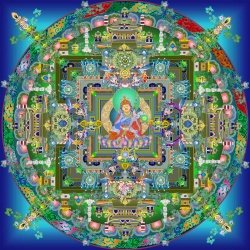Practice of Visualization Meditation
About Visualization
The practice of Visualization is considered to be one of the most powerful meditative practices in the Buddhist tradition.
Whatever the mind can conceive can be visualized, including the vision of the Buddha Amitabha and the Pure Land.
Visualization practice produces a great deal of meditative concentration (Skt. Samadhi) and it also serves to purify unimaginable amounts of harmful karma.
When one attains a clear vision of Amitabha Buddha and the Pure Land, one is said to have attained Nien-Fo Samadhi (Skt. Buddhanusmrti Samadhi).
In the Visualization Sutra, the Buddha instructs Vaidehi to first call up the image of a setting sun, then to inspect it closely, and finally to perceive or "see" the setting sun in the mind.
This is the basis of Pure Land Visualization Meditation.
The Practice
It is common to use the 16 visualizations outlined in the Visualization Sutra as the objects of one's Pure Land Visualization practice. However, a word of caution is prudent at this juncture.
One should not try to do all 16 visualizations in one sitting unless one has been doing this practice for many months, or even years.
The First Visualization, the Visualization of the Setting Sun, is designed as sort of a "warm-up" exercise to get one accustomed to the process of visualization which will be described below.
A much less strenuous visualization is the Purification Visualization, which may be accessed here.
It is also possible to use a single image such as the Buddha Amitabha or the Bodhisattva Kuan-Yin as the object of Visualization Meditation if one desires.
The visualizations of the Visualization Sutra do become very complex, but one should not be intimidated by them if one has done single-minded visualization practice.
The following steps are recommended when doing Visualization Meditation:
Purifying One's Karma.
Recite the following three times:
I acknowledge all deluded karmic actions I have performed through countless cycles of birth and death;
Fueled by my endless greed, anger and ignorance,
And manifested through my bodily actions, speech and thought.
I acknowledge and confess this karma, thereby purifying it.
Dissolving of the Elements and Senses
After assuming a comfortable posture and spending a few minutes regulating the breath, do the following:
Dissolve the earth (solid) elements of the body (skin, muscles, tendons, bones, etc.) followed by the sense of smell.
Dissolve the water (liquid) elements of the body followed by the sense of taste.
Dissolve the air (gaseous) elements of the body followed by the sense of touch.
Dissolve the fire (heat, energy, chi) elements of the body followed by the sense of sight.
Dissolve the space or emptiness element of the body followed by the sense of hearing.
All that remains is pure awareness. Sit as this awareness for a few moments.
The Process of Visualization
Step 1: Imagine/Call Up/Remember/Look At an image. This means to go into your mind and either recall or construct an image.
Step 2: Inspect/Study/Analyze/Examine Closely the image in your mind. Using your mind, look at the details of the image you have called up in very, very fine detail. Omit nothing. Be thorough.
Step 3: See/Hold/Perceive/View this image. Using the power of your mind, try as hard as you can to sustain this image clearly.
Another way to look at this process is:
- Construct an image mentally (even if it comes from a visual source).
- Impress this image on your consciousness by looking at it closely.
- Maintain this image as long as you can so that it stays present.
Mutual Support in the Visualization Process
Remember: Each step in visualization is supported by the step that precedes it.
So whenever it becomes difficult to hold the image in your mind (Step 3), return to examining it closely (Step 2).
Whenever it becomes difficult to examine the mental image closely (Step 2), just restart the entire process (Step 1).
By relying on the principle of Mutual Support, the practice of Visualization Meditation retains its dynamic nature.
With plenty of time, practice and patience, the practice will become stronger and stronger until you can visualize the objects of your meditation clearly at any time.
At that point there is no difference between the mind and the relative world.





